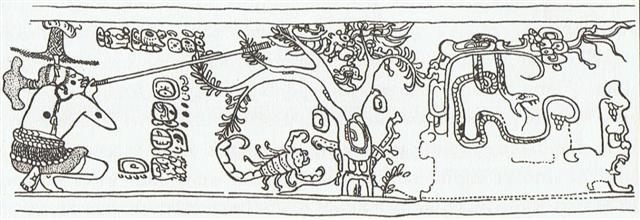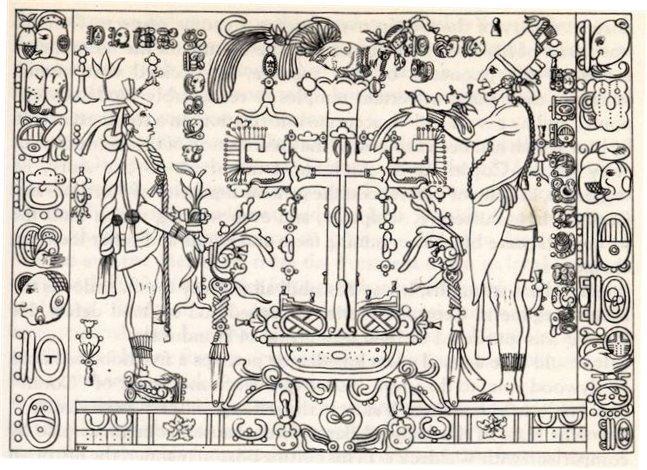2. We had better repeat the basic tables from Camp 6:
I have argued for people remembering (or deducing from their observations) the old world of beautiful order when sky and earth (as seen from a place north of the equator) were linked in harmony so that winter down on earth corresponded to 'winter' as mapped by the stars in the night. This was the state of the world around 90 * 72 = 6480 years ago, ca 4500 B.C., when Orion ruled - the only zodiacal sign of ours which has been drawn below the ecliptic in our overview picture:
Betelgeuze, for example, is today located 89 days beyond spring equinox north of the equator, only 3 days before summer solstice, but in the time of Orion it was close to day zero. At present Betelgeuze is close to summer solstice north of the equator and therefore below the ecliptic. But around 4500 B.C. Orion stood at spring equinox and therefore on the ecliptic. Since then the precession has moved Orion forward in the year to a position below the path of Sun. Perhaps the perspective of precession moving the consecutive stars at spring equinox away from the ecliptic path and downwards was an idea which also was applied to the stars at winter solstice. Also they were similarly pushed forward and out from the important central position, and by the principle of correspondence they could be imagined as pushed down. In the perspective of time we could say that Polaris was pushed down from the spring equinox (day 'zero' position) around 1 / 12 * 26000 = ca 2160 years ago, or close to the beginning of the era of Pisces. I am slightly irritated over not finding any precise value for the great cycle, it can hardly be exactly 26000 years. The only precision I have is that it is 'slightly less than 26000 years'. Suppose a more exact value was 25920 years, then a 'month' would be exactly 2160 years. Perhaps the Easter Islanders used the value 25920 instead of 26000 - because with zero meaning nothing 216 (= 6 * 6 * 6) could refer to such a 'month'. Maybe we now can better understand this myth retold in Hamlet's Mill: "As concerns the removing of the Pole star, the most drastic version is told by the Lapps: When Arcturus (alpha Bootis, supposed to be an archer, Ursa Major being his bow) shoots down the North Nail with his arrow on the last day, the heaven will fall, crushing the earth and setting fire to everything. - U. Holmberg, Finno-Ugric and Siberian Mythology (1964), p. 221. See the drawing made by J. Turi in Das Buch des Lappen Turi (1912), plate XIV: Arcturus = Faytna, Polaris/North Nail = Boaje-naste, or Bohinavlle." Sagittarius and his antipodal lady archer are there, it seems, in order to remove the star which so far has ruled a cardinal point in time. When the Hawaiian king was threatened by a spear (vero) once a year it was a rehearsal down on earth of how the Sun King (the ruling star) was threatened to be removed from his position in the sky. Once upon a time the Sun King was located high above at the north pole but in the present era he arrives at spring equinox each year, this I dimly perceive as a possible interpretation of a difficult subject. According to Maya Cosmos the position for a ruler was high up in a tree: "... Then we learned that five hundred and forty-two days later (1.9.2 in the Maya system), Hun-Nal-Ye 'entered or became the sky' (och ta chan). This 'entering' event occurred on February 5, 3112 B.C. The act of 'entering the sky' is recorded on another extraordinary painted pot.
This pot depicts one of the Hero Twins (One-Ahaw in the Classic texts and One-Hunaphu in the K'iche' Popol Vuh) and a great bird who is trying to land in a huge ceiba tree heavy with fruit. This mythical bird is Itzam-Yeh, Classic prototype of Wuqub-Kaqix, 'Seven-Macaw', of Popol Vuh fame.
In that story, in the time before the sky was lifted up to make room for the light, the vainglorious Seven-Macaw imagined himself to be the sun. Offended by his pride, the Hero Twins humbled him by breaking his beautiful shining tooth with a pellet from their blowgun. This pot shows One-Ahaw aiming at the bird as he swoops down to land in his tree. As Itzam-Yeh lands on his perch, the text tells us he is 'entering or becoming the sky'. This particular 'sky-entering' is not the one mentioned in the Palenque text. It is the final event that occurred in the previous creation before the universe was remade. Before the sky could be raised and the real sun revealed in all its splendor, the Hero Twins had to put the false sun, Itzam-Yeh, in his place. If the date on this pot corresponds to that pre-Creation event, as we believe it does, then Itzam-Yeh was defeated in 12.18.4.5.0 1 Ahaw 3 K'ank'in (May 28, 3149 B.C.). After the new universe was finally brought into existence, First Father also entered the sky by landing in the tree, just as Itzam-Yeh did." The scorpion close by the tree presumably refers to Scorpio. This casts a new light on why king Charles II hid himself up in an oak - it was an attempt to avoid being 'pushed down' after his defeat: ... Robur Carolinum, Charles' Oak, the Quercia of Italy and the Karlseiche of Germany, was formally published by Halley in 1679 in commemoration of the Royal Oak of his patron, Charles II, in which the king had lain hidden for twenty-four hours after his defeat by Cromwell in the battle of Worcester, on the 3rd of September 1651 ... He lay hidden in the foliage for 24 hours and we can guess this day could correspond to raaraa in Gb6-20:
The 3rd of September is not at winter solstice, it is closer to autumn equinox. The Cosmic Tree has, though, not only a vertical trunk but also a horizontal beam:
Once upon a time the cross between the descending Milky Way and the rising ecliptic path of Sun (and the other planets) was at spring equinox north of the equator. From his birth there the Sun King climbed higher and higher as if in a tree. At autumn equinox the Sun King 'died' and his living spirit rose to follow the Milky Way - his spirit was leaving the ecliptic path which from there became 'submerged' until next spring equinox. In the Babylonian zodiac we can deduce it from the picture of Eagle & Dead Man:
|
|||||||||||||||||||||||||||||||||||||||||||||||||||||||||||||||||||||||||||||||||||||||||||||||||||||||||||||||








